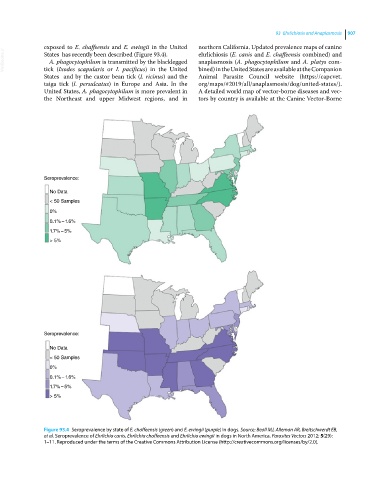Page 969 - Clinical Small Animal Internal Medicine
P. 969
93 Ehrlichiosis and Anaplasmosis 907
exposed to E. chaffeensis and E. ewingii in the United northern California. Updated prevalence maps of canine
VetBooks.ir States has recently been described (Figure 93.4). ehrlichiosis (E. canis and E. chaffeensis combined) and
A. phagocytophilum is transmitted by the blacklegged
anaplasmosis (A. phagocytophilum and A. platys com-
tick (Ixodes scapularis or I. pacificus) in the United
States and by the castor bean tick (I. ricinus) and the bined) in the United States are available at the Companion
Animal Para site Council website (https://capcvet.
taiga tick (I. persulcatus) in Europe and Asia. In the org/maps/#2019/all/anaplasmosis/dog/united‐states/).
United States, A. phagocytophilum is more prevalent in A detailed world map of vector‐borne diseases and vec-
the Northeast and upper Midwest regions, and in tors by country is available at the Canine Vector‐Borne
Seroprevalence:
No Data
< 50 Samples
0%
0.1% –1.6%
1.7% –5%
> 5%
Seroprevalence:
No Data
< 50 Samples
0%
0.1% –1.6%
1.7% –5%
> 5%
Figure 93.4 Seroprevalence by state of E. chaffeensis (green) and E. ewingii (purple) in dogs. Source: Beall MJ, Alleman AR, Breitschwerdt EB,
et al. Seroprevalence of Ehrlichia canis, Ehrlichia chaffeensis and Ehrlichia ewingii in dogs in North America. Parasites Vectors 2012; 5(29):
1–11. Reproduced under the terms of the Creative Commons Attribution License (http://creativecommons.org/licenses/by/2.0).

